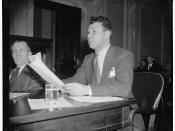In this case study we are going to discuss the CRA case. The CRA case is mainly about the mining company breaking/dissolving the unions and making the employees sign the individual contracts. Here we will discuss and analyse how they went about pursuing the workers to leave the unions and sign the individual contracts. Before that we will briefly look into the profile of the CRA.
CRA is a major Australian mining company, it is a large employer with about 15000 employees directly employed and another 8000 workers in associated companies (Petzall, Abbott and Timo: 2003).
CRA had sales of $ 5.5 billion in 1994 and assets in excess of $ 5 billion. The company has been undergoing a period of restructuring, reflecting the turbulence in mining and commodity markets. CRA suffered a net loss of $ 17.4 million in 1996 down from a profit of $ 295 million in 1995.
CRA 's outputs are very price sensitive with small changes in exchange rate having a large impact in the company's profitability (Petzall, Abbott and Timo: 2003).
The response of CRA was to restructure its operations, introducing a significant change in management style and culture aimed at achieving a greater competitive advantage. (Petzall, Abbott and Timo: 2003).
There were three unions n the CRA namely the AWU, CFMEO and AMFEU. The restructuring of the various operations caused a considerable union tension, fuelled by managerial approach which sought change at any cost. The CRA case is significant because it involved not only 'heart and minds' of employees, but over ideas concerning the role of unions and how employment relations should be managed. It shows how the CRA changed its personal and industrial relations approach to HRM approach. The CRA adopted the method which it saw as a more individualist, employee...


